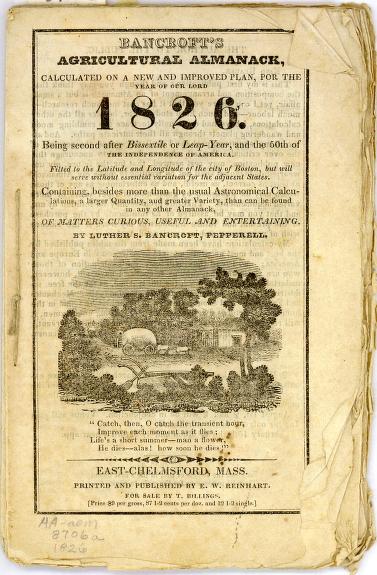|

(c) Pocumtuck Valley Memorial Association, Deerfield MA. All rights reserved.
Agriculture : Agrarian Rhythms
|
|
The earliest New England settlers had stripped the Protestant liturgical calendar of virtually all Saints' and Holy Days, including Christmas. The age-old rhythms of planting and harvest remained intact, however. These agrarian cycles provided the framework around which most people structured their year.
For this reason, almanacs were the most commonly owned books in the colonial period except for the Bible. An almanac was a calendar, a diary, a weather station, and a magazine all rolled into one. Benjamin Franklin noted that his own Pennsylvania Almanac was enormously popular among "the common people, who bought scarcely any other books".
Almanacs remained among the most popular publications in the nineteenth century. Produced annually, these books contained planting lore and weather predictions. They also transmitted biological and scientific theories dating back to ancient Greece. The astrological information they contained, for example, told readers when to plant and harvest. Astrology also often dictated when the healing power of certain medicinal plants and herbs was strongest.
Bancroft's Agricultural Almanack was typical of most almanacs of the period. It informed readers when the sun would rise and set, the phases of the moon, and identified the movements of the planets and the tides. It contained planting schedules and predicted weather conditions. It listed the days on which courts were in session, the major roads and tolls of the region, and current stagecoach schedules. It provided a table for calculating interest on money loaned out at six per cent interest, as well as a chart for converting foreign currency into United States dollars and cents. Like many other almanacs, Bancroft's Almanack also contained agricultural hints, pithy economic advice and amusing anecdotes. These woodcuts and accompanying verses from Bancroft's Agricultural Almanack for 1826 focused on the changing seasons and the agricultural tasks that accompanied them.
top of page
|
"Bancroft's Agricultural Almanack...1826"
| publisher E. W. Reinhart |
| creator Luther S. Bancroft (1804-1872) |
| date 1826 |
| location East Chelmsford, Massachusetts |
| height 7.5" |
| width 4.75" |
| process/materials printed paper, ink |
| item type Books/Almanac |
| accession # #L00.029 |
|





